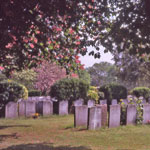York academics' study of the 20th century way of death reveals changing attitudes to mortality
Posted on 1 June 2006

A study by the University of York's Cemetery Research Group examined the management of death during the 1939-1979 period, focusing on the role of cemetery superintendents. The ESRC-funded work was awarded 'Outstanding' by peer reviewers.
Using material, including oral histories, from retired cemetery managers, the study produced remarkably rich - and previously unexplored - data revealing details of emergency burial procedures during the Second World War. Fears about shortages of coffins were endemic during the Blitz, and managers were advised to stockpile shrouds and dig mass graves in advance of air attacks.
The study also looked at the way in which lawn cemeteries - the modern landscape of death - evolved. In focusing on one aspect of the 'management of death', the study was able to draw conclusions about wider trends in bereavement and commemoration through the 20th century.
In the interwar years, the lawn cemetery represented an understated, stoic, and emotionally even response to mortality, and gave cemeteries a new 'ideal' running counter to its Victorian past. Much less evident in the postwar period - the inexorable rise in cremation rates probably undermined the desire to consider idealised cemetery design in any great detail. Indeed, cemeteries were considered to be outmoded 'whitespots' on the landscape.
The shift in the method of disposal reflected social unease with the presence of the corpse and its central role in funeral ritual. Lawn cemeteries minimised any reminder of the physical presence of the dead. But despite a high level of interest in cremation and despite restrictions in cemetery practice, the grave continued to carry emotional significance for many bereaved people - perhaps more so as the lawn cemetery made the private grave, for the first time, affordable to families on lower incomes. The lawn cemetery was a 'democratic' landscape of death, echoing principles of universality and equality that were evident in the development of the Welfare State.
The study has already had substantial impact in helping to revise guidance on cemetery conservation. Twentieth century cemetery landscapes had been difficult to 'read', and were often dismissed through comparison with the more flamboyant Victorian sites.
Now English Heritage has been advised on the need to protect lawn cemetery landscapes, as an important resource in our understanding of death in the modern period. Interest in the research has also been shown by cemetery researchers in places as far afield as Norway and Costa Rica.
The study has had a welcome bonus. A retired cemetery manager living in Harrogate has donated his archive of cemetery journals, conference reports and ephemera to the Cemetery Research Group. 'It's a fantastic resource,' said Dr Julie Rugg. 'The study of cemeteries is becoming a wider and more valued field of research both here and in Europe, and the University is extremely well placed to contribute."
The archive is now being catalogued. Full details will be included in the Cemetery Research Group web pages.
